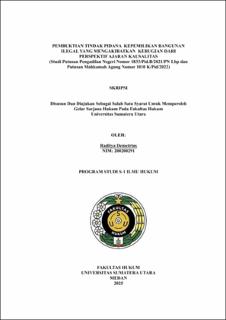| dc.description.abstract | The crime that is currently rampant is the crime of illegal building ownership that
causes losses. The proof of the crime of illegal building ownership that causes
loss requires the application of the doctrine of causality, which aims to find
answers to legal problems or events by searching for and determining the
existence or non-existence of a causal relationship between the act and the
resulting consequence. However, in practice, legal practitioners, especially
judges, often do not apply the doctrine of causality in decision-making. This thesis
contains several problem formulations as follows: 1) How is the relationship
between the proof of criminal elements and the form of the judge's decision
according to Indonesian criminal procedural law?; 2) What is the doctrine of
causality in criminal law?; 3) How do judges consider the proof of the crime of
illegal building ownership that causes loss from the perspective of the doctrine of
causality in the decision of the District Court Number 1833/Pid.B/2021/PN Lbp
and the Supreme Court Decision Number 1010 K/Pid/2022? The research method
used by the author in this study is normative juridical legal research, which
involves using secondary data that consists of primary, secondary, and tertiary
legal materials. The proof of criminal elements must be based on existing
evidence and legal facts to serve as a guideline for the Panel of Judges in
delivering a verdict to the defendant, which can be a sentence, acquittal, or
release. The doctrine of causality in criminal law is used to determine which of a
series of actions is considered the cause of the emergence of the prohibited
consequence, and to determine whether the defendant's actions constitute a
prohibited act punishable under applicable regulations. In the decision of the
District Court Number 1833/Pid.B/2021/PN Lbp, the judge acquitted the
defendant, and in the decision of the Supreme Court Number 1010 K/Pid/2022,
the judge sentenced the defendant to 3 (three) months in prison. The difference in
the verdicts was based on the differing considerations of the judges, where in the
District Court, the elements charged by the Public Prosecutor were not proven,
and to prove the allegations as stated by the prosecutor, the judge required
testimony from a building expert witness. Meanwhile, in the Supreme Court, the
judge stated that the elements of the public prosecutor's charges had been proven,
without requiring proof of the connection between the illegal building and the
losses caused by the illegal building. Which should have led the Supreme Court
judges to uphold the decision of the first-instance judge. | en_US |


